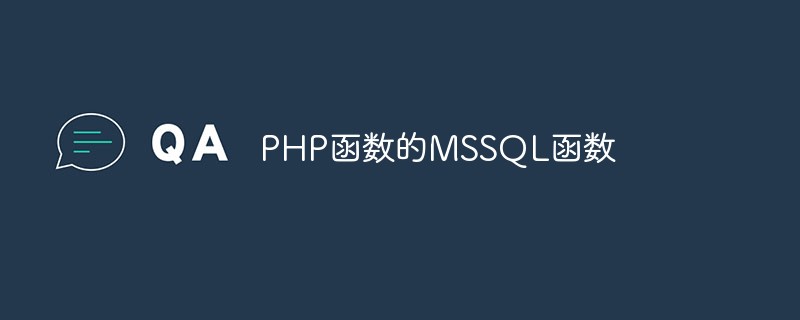The functions in PHP look very simple, but in fact they are very powerful. I can divide them into the following three categories according to whether the function name is fixed:
1. Functions with fixed names:
This type of function, also called: regular function, is created directly using the keyword function. It is also the most familiar type. For example:
<?php
//1按名调用:最直接和普通的方式
echo '1.用function关键字创建常规函数,按函数名称调用:<br>';
function add($a, $b){
return $a.'+'.$b.'='.($a+$b);
};
echo add(5,6);
echo '<hr>';Execution returns:
1. Use function Use keywords to create regular functions and call them by function name:
5+6=11
2. Functions with dynamically set names:
This type of function has many names, such as: anonymous Functions, variable functions, variable functions, closure functions, etc. are actually all the same. Don’t be intimidated by the names.
This kind of dynamically set function is called using the variable name that references this function, so it is very suitable for use in callback functions~~
For teaching purposes, I will collectively refer to it here as: Anonymous function.
There are two main ways to create anonymous functions. Some textbooks talk about them separately, so I will separate them here.
1. Creation method 1: Use PHP’s built-in create_function (parameter list, function body) function to complete. This function has two parameters. These two parameters must be placed in quotation marks. Don’t ask why, that’s how PHP is. According to the regulations, if you are not satisfied, then you can create a programming language~~
<?php //2.用系统函数create_function()来创建一个匿名函数/可变函数/变量函数/闭包函数 echo '2.用内置create_function()函数创建匿名函数,用变量名调用:<br>'; $func1 = create_function('$a,$b','return $a.\'+\'.$b.\'=\'.($a+$b);'); echo $func1(5,6); echo '<hr>';
Execution returns:
2. Use the built-in create_function() function to create an anonymous function and call it with the variable name:
5+6=11
2. Creation method two: Use the function keyword to create. The creation process is the same as a regular function. The difference is that it appears at the position of the value, that is, '= 'The right side of the equal sign. Assign the entire created function to a variable;
<?php
//3匿名函数:也叫闭包函数,将函数做为值赋给一个变量
echo '3.用function关键字创建匿名函数,用变量名调用:<br>';
$func2 = function ($a, $b){
return $a.'+'.$b.'='.($a+$b);
};
echo $func2(5,6);
echo '<hr>';Execution returns:
3. Use the function keyword to create an anonymous function and call it with the variable name:
5+6=11
3. There is no function name. After creation, you can directly pass the parameters and call the execution:
This type of function is similar to the anonymous function, but it is more rough. After creation, just wrap it with parentheses. It can be called after passing in the parameters, so this type of function does not need a name at all and is a one-time function. Just like a disposable item, throw it away after use.
<?php//4自执行函数:创建完立即执行不必明示调用echo '4.用function关键字创建匿名函数,然后直接传参调用执行:<br>';//自运行的匿名函数echo (function ($a,$b){return $a.'+'.$b.'='.($a+$b);})(5,6);Execution return:
4. Use the function keyword to create an anonymous function, and then directly pass the parameters and call the execution:
5+6=11
Summary (very important, must read):
In PHP, the use of functions is still very flexible, but no matter what, functions, in the final analysis, are still a process. At the same time, there must be a return value so that users can perceive its existence and its value!
So, a function is always used as a value. Therefore, it cannot appear on the left side of the equal sign '='. This is the biggest difference between functions and language structures.
For example, we often say: echo() and list() are a language structure, not a function. Although they look like functions, it is because they can be placed on the left side of the equal sign and are acceptable. Assignment. But functions don't work. I hope this article will give you a deeper understanding of functions~~
Source of the article: http://peter.php.cn/blog/detail/188.html
 php函数返回值可以有几个Apr 26, 2022 pm 08:14 PM
php函数返回值可以有几个Apr 26, 2022 pm 08:14 PMphp函数返回值只能有一个。在PHP中,函数返回值使用return语句定义,语法“return 返回值;”。return语句只能返回一个参数,即函数只能有一个返回值;如果要返回多个值的话,就需在函数中定义一个数组,将返回值存储在数组中返回。
 php传参都是字符串吗Dec 15, 2022 pm 03:07 PM
php传参都是字符串吗Dec 15, 2022 pm 03:07 PM不是,php传参可以是字符串、数字、布尔值、数组等。从PHP5.6版本开始支持传递数组参数,函数的形式参数可使用“…”来表示函数可接受一个可变数量的参数,而可变参数将会被当作一个数组传递给函数,语法“function 函数名(...$arr){//执行代码}”。
 php函数的参数赋值有哪几种Apr 24, 2022 pm 12:10 PM
php函数的参数赋值有哪几种Apr 24, 2022 pm 12:10 PMphp函数的参数赋值有3种:1、值传递赋值,将实参的值复制一份再赋值给函数的形参;2、引用传递赋值,把实参的内存地址复制一份,然后传递给函数的形参,进而将实参值赋值给形参;3、直接给函数的参数指定默认值,语法“函数名(参数变量='值')”。
 详细介绍PHP函数和方法的区别Mar 24, 2023 am 09:45 AM
详细介绍PHP函数和方法的区别Mar 24, 2023 am 09:45 AM随着互联网技术的发展,PHP已经成为了非常流行的开发语言之一。身为一个PHP开发者,了解PHP函数和方法的区别是非常重要的,因为它们在编写代码的时候都是必不可少的。在本文中,我们将详细介绍PHP函数和方法的区别。
 PHP函数的命名规范及规则May 19, 2023 am 08:14 AM
PHP函数的命名规范及规则May 19, 2023 am 08:14 AMPHP作为一种非常流行的脚本语言,有着强大的函数库支持,其函数的命名规范和规则对于开发效率和代码可读性都有着重要的影响。本文将介绍PHP函数的命名规范及规则。一、命名风格在PHP中,函数名需要严格符合命名规范和规则,规范主要包括两个方面:命名风格和命名规则。1.下划线命名法下划线命名法是PHP函数命名最常用的方式,也是官方推荐的一种方式。遵循这种方式的函数名
 PHP函数的迭代器函数May 19, 2023 am 08:11 AM
PHP函数的迭代器函数May 19, 2023 am 08:11 AM随着现代编程语言的不断发展,编程的效率和功能性也不断提高,其中PHP作为一种广泛使用的服务器端脚本语言,也在不断地更新和完善其自身的功能列表。PHP函数的迭代器函数就是其中的一种新功能,为PHP程序员提供了更加灵活和高效的编程方式。在本文中,我们将详细介绍PHP函数的迭代器函数的相关知识。什么是PHP函数的迭代器函数?在介绍PHP函数的迭代器函数之前,我们首
 php中递归函数是啥意思May 31, 2022 pm 12:01 PM
php中递归函数是啥意思May 31, 2022 pm 12:01 PM在php中,递归函数指的是自调用函数,也就是函数在函数体内部直接或间接地自己调用自己;使用递归函数时,需要在函数体中附加一个判断条件,以判断是否需要继续执行递归调用,当条件满足时会终止函数的递归调用。
 PHP函数的MSSQL函数May 18, 2023 pm 11:31 PM
PHP函数的MSSQL函数May 18, 2023 pm 11:31 PMPHP是一种开源的服务器端脚本语言,通常用于开发Web应用程序。PHP具有易学易用、灵活、性能优异等优点,因此在Web开发领域得到了广泛应用。而MSSQL作为一种流行的关系型数据库管理系统,也被PHP所支持。在PHP中实现MSSQL数据库操作,需要使用MSSQL函数。MSSQL函数可用于连接数据库、执行查询语句、读写数据库中的数据等操作。接下来,将详细介绍一

Hot AI Tools

Undresser.AI Undress
AI-powered app for creating realistic nude photos

AI Clothes Remover
Online AI tool for removing clothes from photos.

Undress AI Tool
Undress images for free

Clothoff.io
AI clothes remover

AI Hentai Generator
Generate AI Hentai for free.

Hot Article

Hot Tools

MinGW - Minimalist GNU for Windows
This project is in the process of being migrated to osdn.net/projects/mingw, you can continue to follow us there. MinGW: A native Windows port of the GNU Compiler Collection (GCC), freely distributable import libraries and header files for building native Windows applications; includes extensions to the MSVC runtime to support C99 functionality. All MinGW software can run on 64-bit Windows platforms.

mPDF
mPDF is a PHP library that can generate PDF files from UTF-8 encoded HTML. The original author, Ian Back, wrote mPDF to output PDF files "on the fly" from his website and handle different languages. It is slower than original scripts like HTML2FPDF and produces larger files when using Unicode fonts, but supports CSS styles etc. and has a lot of enhancements. Supports almost all languages, including RTL (Arabic and Hebrew) and CJK (Chinese, Japanese and Korean). Supports nested block-level elements (such as P, DIV),

WebStorm Mac version
Useful JavaScript development tools

Atom editor mac version download
The most popular open source editor

ZendStudio 13.5.1 Mac
Powerful PHP integrated development environment






